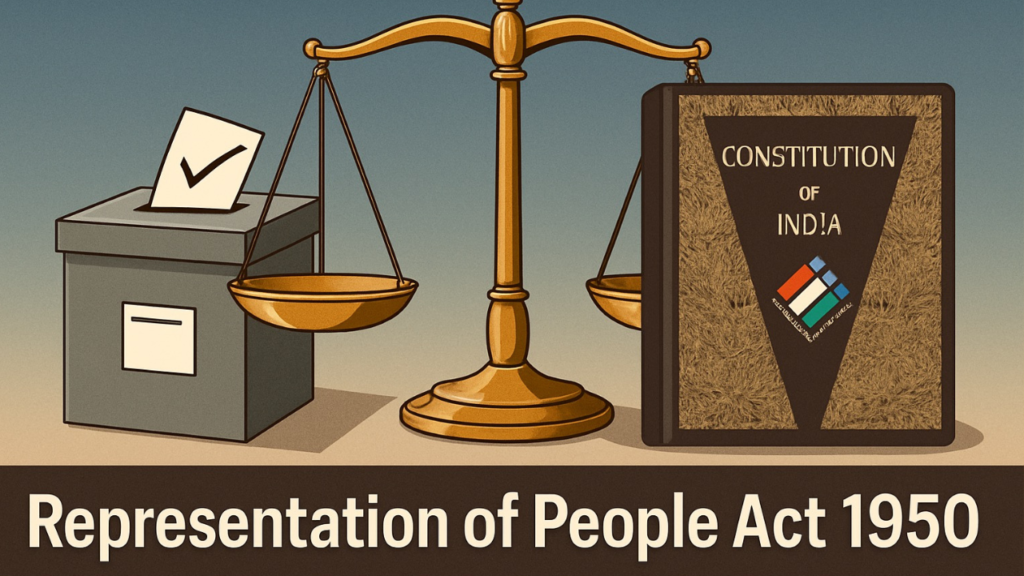“Free and fair elections are the cornerstone of democracy, and the Representation of the People Act, 1950, is the legal bedrock that upholds this fundamental right in India. As the nation evolves, so must the Act, to meet contemporary challenges and safeguard electoral integrity.”
What is RPA 1950?
The Representation of the People Act 1950 (RPA 1950) stands as India’s foundational electoral legislation, enacted on May 12, 1950, under Act No. 43 of 1950. This comprehensive statute provides the legal architecture for seat allocation, constituency delimitation, voter qualifications, and electoral roll preparation for elections to the House of the People and State Legislatures.
Official Legislative Repository:
- Primary Source: India Code – RPA 1950
- Complete Text: CEO Delhi – RPA 1950 PDF
Key sections of RPA 1950
Part II: Allocation of Seats and Delimitation (Sections 3-13)
Section 3 establishes the allocation of seats in the House of the People as specified in the First Schedule, including reservations for Scheduled Castes and Scheduled Tribes[1]. Section 4 mandates that all Lok Sabha seats shall be filled through direct elections from parliamentary constituencies, with each constituency being single-member[1].
Sections 7-9 detail the delimitation framework for Legislative Assemblies. Section 8 empowers the Election Commission to consolidate delimitation orders into the Delimitation of Parliamentary and Assembly Constituencies Order, which “shall have the force of law and shall not be called in question in any court”[1]. This legal immunity clause has contemporary relevance in delimitation disputes.
Part IIA: Officers (Sections 13A-13CC)
Section 13A – Chief Electoral Officers:
- Sub-section (1): “There shall be for each State a chief electoral officer who shall be such officer of Government as the Election Commission may, in consultation with that Government, designate or nominate in this behalf”[2][4][5]
- Sub-section (2): CEOs shall “supervise the preparation, revision and correction of all electoral rolls in the State under this Act” subject to ECI’s “superintendence, direction and control”[2][4]
Section 13AA establishes District Election Officers (DEOs) who coordinate electoral work within districts under CEO supervision[2]. Section 13CC deems all election officers as being “on deputation to the Election Commission” during their electoral duties, ensuring ECI’s administrative control[1].
Part III: Electoral Rolls for Assembly Constituencies (Sections 14-25A)
Section 16 – Disqualifications for Registration:
- Sub-section (1): A person is disqualified if they:
- (a) “is not a citizen of India”
- (b) “is of unsound mind and stands so declared by a competent court”
- (c) “is for the time being disqualified from voting under the provisions of any law relating to corrupt practices and other offences in connection with elections”[1][6]
Section 19 – Conditions of Registration:
“Every person who (a) is not less than eighteen years of age on the qualifying date, and (b) is ordinarily resident in a constituency, shall be entitled to be registered in the electoral roll for that constituency”[1][6][7][8]
Section 21 – Preparation and Revision of Electoral Rolls:
- Sub-section (1): Electoral rolls must be prepared “by reference to the qualifying date and shall come into force immediately upon its final publication”
- Sub-section (2): Rolls shall be revised before general elections and bye-elections unless ECI directs otherwise “for reasons to be recorded in writing”[1][9][10]
Contemporary ECI Challenges Through RPA 1950 Lens
1. Electoral Roll Accuracy and Voter Registration Crisis
Despite Section 19’s clear eligibility criteria, India faces a massive electoral participation deficit. Over 30 crore eligible citizens remain absent from voter rolls, highlighting systemic failures in Section 21’s revision mechanisms[11]. The ECI’s challenges include:
- Migration-related Exclusions: Section 20’s “ordinarily resident” definition struggles with India’s mobile workforce. The provision that “a person absenting himself temporarily from his place of ordinary residence shall not by reason thereof cease to be ordinarily resident therein” fails to address permanent interstate migration[1]
- Technological Integration: RPA 1950 predates digital governance, creating legal ambiguities around Aadhaar-based verification and online registration processes[12]
Current Initiatives and Legal Gaps:
The ECI’s Remote Electronic Voting Machine (RVM) pilots for migrants operate in a legal grey area, as Section 21 doesn’t explicitly provide for remote voting mechanisms[12]. This necessitates either legislative amendments or comprehensive rule-making under Section 28.
2. Model Code of Conduct: Statutory Vacuum
RPA 1950 contains no provisions for the Model Code of Conduct (MCC), creating a fundamental enforcement challenge. The MCC operates purely on moral authority, lacking the legal teeth provided to electoral offences under the Representation of the People Act, 1951[13][14][15][16].
Legal Implications:
- The 2025 Kashmir Court ruling in the Waheed ur Rehman Para case explicitly stated: “By no means can the Model Code of Conduct be classified as an order under section 188 of the IPC”
- Standing Committee on Law and Justice (2013) recommended giving “statutory backing to the Model Code of Conduct leaving no vacuum for the Election Commission of India (ECI) to exercise its residuary power”
3. ECI Independence and Appointment Controversies
Section 13A’s consultation requirement between ECI and state governments for CEO appointments has become contentious. The 2023 Chief Election Commissioner and Other Election Commissioners Act represents a significant departure from traditional appointment practices, raising constitutional concerns.
Current Legal Challenges:
- The Supreme Court case Jaya Thakur v. Union of India challenges whether the 2023 Act nullifies the Anoop Baranwal (2023) decision requiring collegium-style appointments[20]
- Civil society concerns that the new selection committee (PM, Home Minister, LoP, CJI, plus two eminent persons) doesn’t ensure genuine independence

4. EVM Integrity and Legal Framework
While RPA 1950 doesn’t specify voting technology, Section 21’s requirement for transparent electoral roll preparation extends to voting methods. Recent EVM controversies highlight legal gaps:
Contemporary Debates:
- The 2025 CEC statement that EVMs “have repeatedly passed the test of judicial scrutiny…on 42 separate occasions” demonstrates judicial confidence, yet public skepticism persists
- International concerns (like Tulsi Gabbard’s 2025 comments about EVM vulnerabilities) create diplomatic complications, though India’s EVMs operate on different technical specifications
Legal Reform Imperatives
1. Comprehensive Amendment Requirements
Section 28’s rule-making power enables procedural reforms, but substantive changes require legislative action:
- Statutory MCC: Incorporating MCC provisions within RPA 1950 would provide legal enforceability
- Digital Infrastructure: Explicit provisions for online voter registration, digital verification, and remote voting
- Migration Provisions: Revised definitions of “ordinarily resident” accounting for modern mobility patterns
2. Independence Safeguards
Section 13CC’s deputation framework requires strengthening through:
- Constitutional amendments ensuring ECI’s independent secretariat
- Restrictions on post-retirement appointments for election officials
- Enhanced tenure security provisions
3. Transparency Mechanisms
Section 21’s revision procedures need digital-age updates:
- Mandatory online publication of all electoral roll changes
- Real-time grievance redressal systems
- Automated cross-verification with demographic databases

Judicial Interpretations and Precedents
Recent Supreme Court pronouncements have shaped RPA 1950’s application:
- SC’s 2024 EVM Ruling: Dismissed PIL seeking ballot paper return, reaffirming EVM legality under existing legal framework[25]
- Anoop Baranwal (2023): Mandated collegium system for ECI appointments, leading to the controversial 2023 Act[11][19]
Opinion
The Representation of the People Act, 1950 remains India’s electoral bedrock, yet its 75-year-old provisions strain under contemporary challenges. For legal practitioners, understanding RPA 1950’s intersection with current ECI operations is essential for electoral jurisprudence.
Key areas requiring immediate attention include:
- Statutory backing for MCC under Part V
- Digital governance provisions within Section 21
- Enhanced independence mechanisms in Part IIA
- Comprehensive voter registration reforms in Part III
The Act’s evolution reflects Indian democracy’s maturation, yet significant gaps remain. As the 2025 electoral cycle approaches, RPA 1950’s adequacy in governing modern elections will face unprecedented scrutiny.
Essential Legal Resources:
- Primary Legislation: India Code Portal
- Comprehensive PDF: CEO Delhi Manual[1]
- Legislative Dashboard: Parliamentary Law Repository
- Registration Rules: India Code – RER 1960
Sources:-
[1] [PDF] THE REPRESENTATION OF THE PEOPLE ACT, 1950
[2] [PDF] representations of the people act 1950 part iia officers
[3] Representation of the People Act, 1950 – India Code
[4] Chief Electoral Officer – Representation of the People Act, 1950
[5] Section 13A of RPA – Chief Electoral Officers
[6] [PDF] HAND BOOK FOR BOOTH LEVEL OFFICERS – CEO , JK
[7] Section 19 The Representation of the People Act, 1950
[8] Section 19: Conditions Of Registration – KanoonGPT
[9] [PDF] Hand Book for Electoral Registration Officers
[10] Section 21: Preparation And Revision Of Electoral Rolls – KanoonGPT
[11] Election Commission of India: Pillars of Electoral Governance
[12] Election Commission of India (ECI) | Current Affairs
[13] Model Code of Conduct – Vajiram & Ravi
[14] Model Code of Conduct (MCC): Meaning, Evolution, Features & More
[15] Code of Conduct for Political Parties and Anti- Defection Law
[16] Model Code of Conduct – Drishti IAS
[17] Model Code of Conduct can’t be classified as order under IPC …
[18] Appointment of CEC and EC – Drishti IAS
[19] New Election Commission Appointment: A Closer Look at the ECI …
[20] Challenges to the Appointment of Election Commissioners Act, 2023
[21] appointments to the office of the Election Commission of India (ECI …
[22] [Solved] In the light of recent controversy regarding the use of Elec
[23] EVMs ‘tamper proof’: Election Commission clarifies after Tulsi …
[24] “No Drawback In EVMs, Not Going Back To Paper Ballots”: Poll …
[25] SC Upholds EVM and VVPAT System – Drishti IAS
[26] The Representation of The people act, 1951 (Act no. 43 of 1951).
[27] [PDF] THE REGISTRATION OF ELECTORS RULES, 19601 – India Code
[28] [PPT] PowerPoint Presentation – CEO , JK
[29] [PDF] 1 THE REPRESENTATION OF THE PEOPLE ACT, 1950
[30] [PPT] General Principles of Voter Registration – CEO , JK


